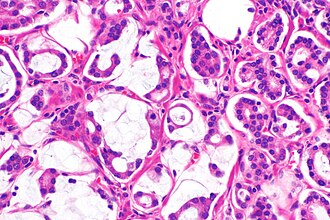Difference between revisions of "Mucinous adenocarcinoma of the prostate"
Jump to navigation
Jump to search
| Line 3: | Line 3: | ||
| Image = Mucinous adenocarcinoma of prostate - 2b -- high mag.jpg | | Image = Mucinous adenocarcinoma of prostate - 2b -- high mag.jpg | ||
| Width = | | Width = | ||
| Caption = Mucinous adenocarcinoma of the prostate. [[H&E stain]]. (WC/Nephron) | | Caption = Mucinous adenocarcinoma of the prostate (left) with acinar adenocarcinoma of the prostate (right). [[H&E stain]]. (WC/Nephron) | ||
| Synonyms = | | Synonyms = | ||
| Micro = cytologically malignant (prostatic) cells floating in mucin; >25% of tumour mucinous | | Micro = cytologically malignant (prostatic) cells floating in mucin; >25% of tumour mucinous | ||
Revision as of 03:17, 13 June 2016
| Mucinous adenocarcinoma of the prostate | |
|---|---|
| Diagnosis in short | |
 Mucinous adenocarcinoma of the prostate (left) with acinar adenocarcinoma of the prostate (right). H&E stain. (WC/Nephron) | |
|
| |
| LM | cytologically malignant (prostatic) cells floating in mucin; >25% of tumour mucinous |
| LM DDx | acinar adenocarcinoma of the prostate with a minor mucinous component (<25%), metastatic mucinous carcinoma, mucinous adenocarcinoma of the prostatic urethra |
| Grossing notes | prostatectomy grossing, TURP specimens |
| Site | prostate gland - see prostate cancer |
|
| |
| Prevalence | rare |
| Blood work | PSA elevated |
| Prognosis | dependent on grade |
| Treatment | prostatectomy, radiation or observation |
Mucinous adenocarcinoma of the prostate is an uncommon type of prostate cancer.
General
Gleason pattern:
- In the past, it has been suggested that the mucinous component be assigned Gleason pattern 4.[2]
- The prognosis is similar or may be better than the conventional type of prostate cancer in a large series;[1] thus, it seems reasonable to grade based on the pattern (as advocated by some experts[3]).
Microscopic
Features:
- Cytologically malignant cells floating in mucin.
- > 25% of tumour mucinous.[2]
Notes:
- Mucinous carcinoma - percentage required to call varies by site.
DDx:
- Metastatic mucinous carcinoma.
- Mucinous adenocarcinoma of the prostatic urethra - analogous to the mucinous adenocarcinoma of the urinary bladder.[5]
Images
See also
References
- ↑ 1.0 1.1 1.2 Osunkoya, AO.; Nielsen, ME.; Epstein, JI. (Mar 2008). "Prognosis of mucinous adenocarcinoma of the prostate treated by radical prostatectomy: a study of 47 cases.". Am J Surg Pathol 32 (3): 468-72. doi:10.1097/PAS.0b013e3181589f72. PMID 18300802.
- ↑ 2.0 2.1 Grignon DJ (March 2004). "Unusual subtypes of prostate cancer". Mod. Pathol. 17 (3): 316–27. doi:10.1038/modpathol.3800052. PMID 14976541.
- ↑ Osunkoya, AO.; Adsay, NV.; Cohen, C.; Epstein, JI.; Smith, SL. (Jul 2008). "MUC2 expression in primary mucinous and nonmucinous adenocarcinoma of the prostate: an analysis of 50 cases on radical prostatectomy.". Mod Pathol 21 (7): 789-94. doi:10.1038/modpathol.2008.47. PMID 18487999.
- ↑ Osunkoya AO, Nielsen ME, Epstein JI (March 2008). "Prognosis of mucinous adenocarcinoma of the prostate treated by radical prostatectomy: a study of 47 cases". Am. J. Surg. Pathol. 32 (3): 468–72. doi:10.1097/PAS.0b013e3181589f72. PMID 18300802.
- ↑ 5.0 5.1 Bohman, KD.; Osunkoya, AO. (Nov 2012). "Mucin-producing tumors and tumor-like lesions involving the prostate: a comprehensive review.". Adv Anat Pathol 19 (6): 374-87. doi:10.1097/PAP.0b013e318271a361. PMID 23060063.







